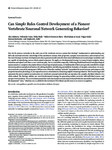Can Simple Rules Control Development of a Pioneer Vertebrate Neuronal Network Generating Behavior?
| dc.contributor.author | Roberts, A | |
| dc.contributor.author | Conte, D | |
| dc.contributor.author | Hull, M | |
| dc.contributor.author | Merrison-Hort, R | |
| dc.contributor.author | al Azad, AK | |
| dc.contributor.author | Buhl, E | |
| dc.contributor.author | Borisyuk, R | |
| dc.contributor.author | Soffe, SR | |
| dc.date.accessioned | 2018-03-27T10:29:40Z | |
| dc.date.available | 2018-03-27T10:29:40Z | |
| dc.date.issued | 2014-01-08 | |
| dc.identifier.issn | 0270-6474 | |
| dc.identifier.issn | 1529-2401 | |
| dc.identifier.uri | http://hdl.handle.net/10026.1/11181 | |
| dc.description.abstract |
<jats:p>How do the pioneer networks in the axial core of the vertebrate nervous system first develop? Fundamental to understanding any full-scale neuronal network is knowledge of the constituent neurons, their properties, synaptic interconnections, and normal activity. Our novel strategy uses basic developmental rules to generate model networks that retain individual neuron and synapse resolution and are capable of reproducing correct, whole animal responses. We apply our developmental strategy to young<jats:italic>Xenopus</jats:italic>tadpoles, whose brainstem and spinal cord share a core vertebrate plan, but at a tractable complexity. Following detailed anatomical and physiological measurements to complete a descriptive library of each type of spinal neuron, we build models of their axon growth controlled by simple chemical gradients and physical barriers. By adding dendrites and allowing probabilistic formation of synaptic connections, we reconstruct network connectivity among up to 2000 neurons. When the resulting “network” is populated by model neurons and synapses, with properties based on physiology, it can respond to sensory stimulation by mimicking tadpole swimming behavior. This functioning model represents the most complete reconstruction of a vertebrate neuronal network that can reproduce the complex, rhythmic behavior of a whole animal. The findings validate our novel developmental strategy for generating realistic networks with individual neuron- and synapse-level resolution. We use it to demonstrate how early functional neuronal connectivity and behavior may in life result from simple developmental “rules,” which lay out a scaffold for the vertebrate CNS without specific neuron-to-neuron recognition.</jats:p> | |
| dc.format.extent | 608-621 | |
| dc.format.medium | ||
| dc.language | en | |
| dc.language.iso | eng | |
| dc.publisher | Society for Neuroscience | |
| dc.subject | axon guidance | |
| dc.subject | growth cone | |
| dc.subject | locomotion | |
| dc.subject | rhythms | |
| dc.subject | Xenopus | |
| dc.title | Can Simple Rules Control Development of a Pioneer Vertebrate Neuronal Network Generating Behavior? | |
| dc.type | journal-article | |
| dc.type | Article | |
| plymouth.author-url | https://www.ncbi.nlm.nih.gov/pubmed/24403159 | |
| plymouth.issue | 2 | |
| plymouth.volume | 34 | |
| plymouth.publication-status | Published | |
| plymouth.journal | The Journal of Neuroscience | |
| dc.identifier.doi | 10.1523/jneurosci.3248-13.2014 | |
| plymouth.organisational-group | /Plymouth | |
| plymouth.organisational-group | /Plymouth/Faculty of Science and Engineering | |
| plymouth.organisational-group | /Plymouth/REF 2021 Researchers by UoA | |
| plymouth.organisational-group | /Plymouth/REF 2021 Researchers by UoA/UoA11 Computer Science and Informatics | |
| plymouth.organisational-group | /Plymouth/Users by role | |
| plymouth.organisational-group | /Plymouth/Users by role/Researchers in ResearchFish submission | |
| dc.publisher.place | United States | |
| dc.identifier.eissn | 1529-2401 | |
| dc.rights.embargoperiod | Not known | |
| rioxxterms.versionofrecord | 10.1523/jneurosci.3248-13.2014 | |
| rioxxterms.licenseref.uri | http://www.rioxx.net/licenses/all-rights-reserved | |
| rioxxterms.type | Journal Article/Review | |
| plymouth.funder | Cross-modality integration of sensory signals leading to initiation of locomotion::BBSRC | |
| plymouth.funder | Cross-modality integration of sensory signals leading to initiation of locomotion::BBSRC | |
| plymouth.funder | Cross-modality integration of sensory signals leading to initiation of locomotion::BBSRC | |
| plymouth.funder | Cross-modality integration of sensory signals leading to initiation of locomotion::BBSRC |


